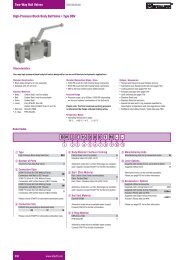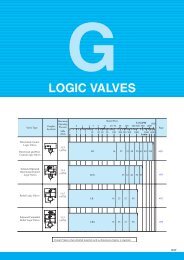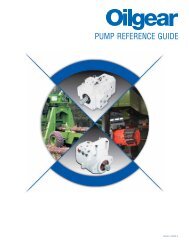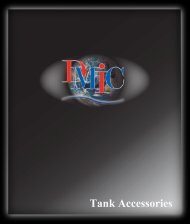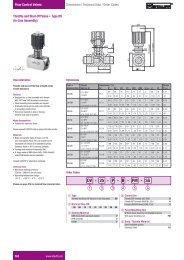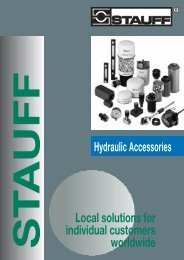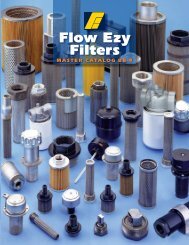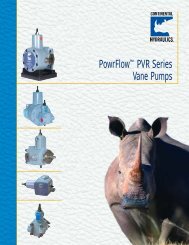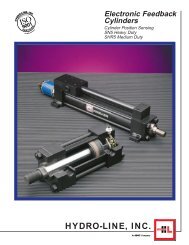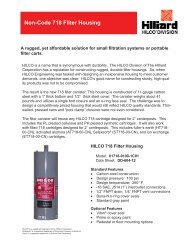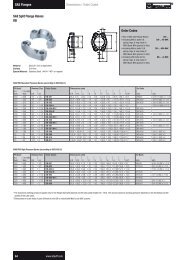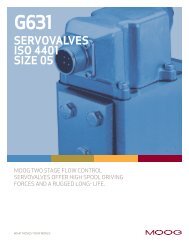Electrohydraulic Valves - Moog Inc
Electrohydraulic Valves - Moog Inc
Electrohydraulic Valves - Moog Inc
- No tags were found...
Create successful ePaper yourself
Turn your PDF publications into a flip-book with our unique Google optimized e-Paper software.
<strong>Electrohydraulic</strong> <strong>Valves</strong>...A Technical Look
ELECTROHYDRAULIC VALVE APPLICATIONS<strong>Moog</strong> <strong>Inc</strong>. was the founded in 1951 by William C. <strong>Moog</strong>,inventor of the <strong>Electrohydraulic</strong> Servovalve.His creation heralded a new era in precision control. Italso spurred the growth of <strong>Moog</strong> to become the world leaderin design and manufacture of electrohydraulic control productsand systems. During the past decade the company has extendedits control expertise into Servo-Proportional <strong>Valves</strong>, ServoElectronics and Direct Drive <strong>Valves</strong>.<strong>Moog</strong> products provide precise control of position, velocityand force – so important to the proper operation of a widevariety of industrial machinery.For example:➣ <strong>Moog</strong> <strong>Inc</strong>. Servoactuators accurately control the thicknessof steel slabs in continuous casting operations.➣ <strong>Moog</strong> <strong>Inc</strong>. ServoJet ® Servo-Proportional <strong>Valves</strong> control bothvelocity and pressure in plastic injection molding machinesand wall thickness in plastic blow molding machines.➣ <strong>Moog</strong> <strong>Inc</strong>. Direct Drive <strong>Valves</strong> control the thickness of paperon new “state of the art” paper machines.APPLICATIONSIndustrialBasic Metal ProcessingBlow/Injection MoldingEarthquake SimulationEntertainment EquipmentFatigue TestingFlight SimulationGas, Steam & Hydro TurbinesMachine ToolsManufacturing SystemsMaterial TestingPaper MachinesRoboticsRubber ProcessingSaw & Veneer Mill MachinesSteel & Aluminum Mill EquipmentMobile/MarineActive SuspensionForestry MachinesMining MachineryRailroadsRemote ControlSeismic ExplorationShipsSubmersiblesVibration ReductionENGINEERING ASSISTANCEThe information contained in this catalog presents typicalproducts offered by <strong>Moog</strong>; our true expertise is helping you solveyour motion control problems. Our engineering staff is availableto assist you in your efforts to accurately and precisely controlposition, velocity or force in your specific application. Often timesthis results in designing a customized design and product, specificallysuited to your need. <strong>Moog</strong>’s capabilities in this respect areunmatched in industry. So call us and let us know how we canhelp… you will be glad you did.Due to our policy of continual research and improvement,we reserve the right to change specifications in this catalogwithout notice.ApplicationsApplicationsEach of these applications involves precise control of a complexstructure, which in most cases is subject to varying loadsthat can adversely affect performance. <strong>Moog</strong> products overcomethe structural and load variation effects through the principlesof feedback. <strong>Moog</strong> transducers measure the output, which couldbe position, velocity, pressure or acceleration and send signalsto the machine controller.These signals are compared with thedesired output.The sensing and correcting on a continuous basisresults in optimum system performance.2
ELECTROHYDRAULIC VALVE SELECTION GUIDE<strong>Moog</strong> offers the broadest line of <strong>Electrohydraulic</strong> <strong>Valves</strong> onthe market today. Our product line consists of Servovalves(Mechanical and Electric Feedback versions) and Servo-Proportional <strong>Valves</strong> (Direct Drive and Two Stage ServoJet ®versions). Servovalves typically utilize a ISO10372 mountingpattern and are nearly always zero lapped or axis cut (nomechanical deadband). Servo-Proportional <strong>Valves</strong> utilize anISO4401 mounting pattern and may have a mechanical deadband.Selection of the proper valve involves understanding theperformance requirements of your application.The chart belowattempts to categorize the more popular <strong>Moog</strong> valve series bytwo very important selection criteria – flow and dynamic response.Selection1000500400300200D665D664D66379-200D68X79-200 HRD662100FLOW WITH 1000 psi SERVOVALVE DROP - gpm70504030201075432D6617279-100D634G761/D765 STDD765 HRD765 SHRDDV VALVESERVOVALVE10.7G631D6330.50.40.30.25 7 10 20 30 40 50 70 100 200 300 400 500 700 1000FREQUENCY OF SERVOVALVE 90˚ PHASE LAG – Hz(SMALL TO MEDIUM SIGNAL RESPONSE)SERVOJET ®3
HOW TO SELECT A SERVO OR PROPORTIONAL VALVEDETERMINE THE REQUIRED VALVE FLOW RATE ANDFREQUENCY RESPONSEa) In order to compensate for unknown forces, size the actuatorarea to produce a stall force 30% greater than the desired forceto the supply pressure available.A =1.3 FRPSwhere:A = actuator area (in 2 )FR = force required to movethe load (lb) at maximumvelocity, ref. key parametersPS = supply pressure (psi)Refer to the NFPA standard cylinder bore and rod sizes andselect the area closest to the result of the above calculations.b)From the maximum required loaded velocity and the actuatorarea from the above calculation, determine the valve loadedflow and the load pressure drop.where:QL = loaded flow (in 3 /sec)QL = AXLXL = maximum requiredloaded velocity (in/sec)PL =FRAwhere:PL = load pressure drop (psi)KEY PARAMETERS FOR SERVO OR PROPORTIONALVALVE SELECTIONSupply PressureServovalve and ServoJet ® <strong>Valves</strong> are intended to operate withconstant supply pressure and require continuous pilot flow tomaintain the hydraulic bridge balance.The supply pressure shouldbe set so that the pressure drop across the valve is equal to onethirdof the supply pressure.The flow capacity should include thecontinuous pilot flow to maintain the hydraulic bridge balance.Direct Drive Valve performance is constant no matter what thesupply pressure.Therefore, they are good in systems with fluctuatingsupply pressures.Standard <strong>Moog</strong> <strong>Inc</strong>. valves will operate at supply pressuresfrom 200 to 3,000 psi. Optional valves for 50 to 5,000 psioperation are available. Refer to individual valve specifications.Type of Fluid<strong>Moog</strong> <strong>Inc</strong>. valves operate most effectively with fluids that exhibita viscosity of 60 to 450 SUS at 100˚F. Due to the Servovalve operatingrange of -40˚F to 275˚F, care should be taken to assure fluidviscosity does not exceed 6,000 SUS. In addition, fluid cleanliness isof prime importance and should be maintained at ISO DIS 4406Code 16/13 max, 14/11 recommended. Consult the <strong>Moog</strong> <strong>Inc</strong>.Filtration and Valve Series catalogs for recommendations.Fluid compatibility with material used in the constructionof valves must be considered. Contact the factory for specificinformation.c) Compute the no-load flow.QNL = QLPSPS -PLwhere:QNL= no-load flow (in 2 /sec)d)Determine the valve rated flow at 1,000 psi valve drop forServovalves and 150 psi valve drop for Proportional <strong>Valves</strong>.<strong>Inc</strong>rease by 10% for margin.QNLQR = 1.1 ( )e)For open-loop control, a valve having a 90˚ phase lag at 3 Hzor higher, should be adequate.f) For closed loop control of systems utilizing electrical feedback,calculate the load natural frequency using the equations in thisbrochure under “Load Resonant Frequency”.The optimum performancewill be achieved if the Servovalve 90˚ phase point exceedsthe load resonant frequency by a factor of three or more.g) With a calculated flow rate and frequency response, referencethe Valve Selection Table on page 3 for valve selection. AnyServovalve that has equal or higher flow capacity andresponse will be an acceptable choice. However, it is preferablenot to oversize the Servovalve flow capacity as this willneedlessly reduce system accuracy.h)Consult individual data sheets for complete valve performanceparameters.Force RequirementsIn most applications, a portion of the available supply pressuremust be used to overcome some force. Since valve flow ratings aregiven as a function of pressure drop across the valve, total forcerequirements must be known in order to determine what portionof the supply pressure is available to be dropped across the valve.Total force is the summation of all individual forces that occur dueto the static or dynamic configuration of the system.10% pad where:FR = FL + FA + FE + FS where:QR = Servovalve rated flowFR = total required force (lb)(gpm) at 1,000 psi drop3.8FLor Proportional Valve= force due to load (lb)in 3 FA/sec to gpm conversionrated flow at 150 psi drop= force due to acceleration (lb)FE = force due to external disturbance (lb)FS = force due to seal friction (lb)Force Due to a LoadForce due to a load FL can be an aiding or resistive component,depending upon the load’s orientation and direction of travel.Consideration has to be taken when computing FL to ensure theproper external friction coefficients and resolved forces are used.WLRESISTIVELOADPISTONEXTENDINGWLAIDINGLOADPISTONRETRACTING4
Force Due to AccelerationThe forces required to overcome inertia become very largein high speed applications and are critical to valve sizing.FA = Maa =WLØFL = mWLcosØ (lb)VMAXTaWL +WPM =gFLForce Due to External DisturbancesThese forces can be generated by constant or intermittentsources.FECONSTANTEXTERNALCOMPRESSIONOR TENSILEFORCEDEFORMATIONFORCEForce Due to Seal FrictionMost valves are used on applications which employ some sortof motion device.These motion devices usually utilize elastomerseals to separate the various pressure chambers.The frictionbetween these seals and the moving parts acts as opposing force.FS = 0.1 FMAXStandard practice involves setting seal friction at 10% ofthe maximum force available, unless absolute values are known.FEWLFL = mWLWL = weight of load (lb)m = coefficient of frictionwhere:M = mass (lb - sec 2 /in)a = acceleration (in/sec 2 )WP = weight of piston (lb)VMAX = maximum velocity (in/sec)Ta = time period foracceleration (sec)WL = weight of loadPRESSINTERMITTENTwhere:FMAX = stall force (lb)FLDynamic ResponseTYPICAL BODE PLOT OF DYNAMIC RESPONSE42502250200175-4150125-89075-125025-1605 10 20 30 50 100 200 300 500HzKO KS (lb/in)KA =KO + KS1 KOƒNpiston (in 2 )XTwhere:XmVA valve’s dynamic response can be easily determined by measuringthe frequency at which the phase lag between the input currentand output flow reaches 90˚ (90˚ phase lag point).The frequencyresponse will vary with input signal amplitude, supply pressure,and fluid temperature.Therefore, comparisons must use consistentdata.The recommended peak-to-peak signal amplitude is 80%of the valve rated current. Servovalve and ServoJet ® response willimprove somewhat with higher supply pressure, and generallydepreciate at both high and low temperatures. Direct Drive Valveresponse is independent of supply pressure.Load Resonant FrequencyOpen loop control consists of a human operator monitoring theparameter (i.e., position or speed) and varying the input of thecontrol valve to obtain the desired result. Closed loop control iscapable of fast, more accurate control and requires a high performancecontrol valve. For optimum performance, the valves 90˚phase point should exceed the load resonant frequency by a factorof three or more. Load resonance is determined by the overallstiffness (KA), which is the combination of the hydraulic stiffness(KO) and the structural stiffness (KS), given by:The load resonant frequency for an equal area cylinder is given by:MƒN = 2¹= load resonant frequency (Hz)KO = hydraulic stiffness (lb/in)where:where:ß = bulk modulus of fluid used (psi)A = working area of double ended4s ßAKO =XTs =AXmDegrees(˚)= total piston stroke (in)s = actuator volumetric efficiency= piston stroke used forapplication (in)V = total volume of fluid betweenvalve control ports andthe piston (in 3 )NOTE:Typical bulk modulus (ß) Å 2.0 x 10 5 psi5
ELECTROHYDRAULIC VALVE PILOT STAGE ANDSPOOL ACTUATION TECHNOLOGIESNozzleFeedbackWireCoilsTechnologyArmatureFlapperNOZZLE FLAPPER TORQUE MOTOR DESCRIPTIONAn electrical command signal (flow rate set point) is applied tothe torque motor coils and creates a magnetic force which actson the ends of the pilot stage armature.This causes a deflectionof armature/flapper assembly within the flexure tube. Deflectionof the flapper restricts fluid flow through one nozzle which iscarried through to one spool end, displacing the spool. [Spoolactuation relative to valve operation is detailed on page 17]Movement of the spool opens the supply pressure port (P)to one control port while simultaneously opening the tank port(T) to the other control port.The spool motion also applies aforce to the cantilever spring, creating a restoring torque on thearmature/flapper assembly.Once the restoring torque becomes equal to the torquefrom the magnetic forces, the armature/flapper assembly movesback to the neutral position, and the spool is held open in a stateof equilibrium until the command signal changes to a new level.In summary, the spool position is proportional to the inputcurrent and, with constant pressure drop across the valve, flow tothe load is proportional to the spool position.TechnologySERVOJET ® DESCRIPTIONAnnularAreaNozzleJetPipeReceiverThe ServoJet ® pilot stage consists mainly of torque motor, jet pipeand receiver.A current through the coil displaces the jet pipefrom its neutral position.This displacement, combined with thespecial shape of the jet pipe, directs a focused fluid jet towardsone side of the receiver.The jet now produces a pressure difference across the endsof the spool.This pressure difference causes a spool displacementwhich, in turn, results in control port flow.The pilot stage drain isthrough the annular area around the nozzle to tank.CableHolePermanentMagnetsCenteringSpringsLINEAR FORCE MOTOR DESCRIPTIONBearingCoilArmaturePlug<strong>Moog</strong>’s Direct Drive <strong>Valves</strong> use our proprietary linear forcemotor. A linear force motor is a permanent magnet differentialmotor.The permanent magnets provide part of the requiredmagnetic force.The linear force motor has a neutral mid-positionfrom which it generates force and stroke in both directions. Forceand stroke are proportional to current.High spring stiffness and the resulting centering force, plusexternal forces (i.e. flow forces, friction forces due to contamination),must be overcome during outstroking. During backstrokingto center position, the spring force adds to the motor force andprovides additional spool driving force making the valve lesscontamination sensitive.The linear force motor requires very lowcurrent in the spring centered position.6
TYPES OF SERVO SYSTEMSPOSITION SERVO SYSTEMA load positioning servo system is comprised of a Servo, ServoJet ®or Direct Drive Valve, actuator, position feedback transducer,position command generator, and a Servoamplifier. A typical linearposition servo system using a double-ended piston is shown tothe right (a rotary position servo system can be created bysubstituting the appropriate rotary components).The valve’s two output control ports are connected acrossthe load cylinder. In the Servoamplifier, the command input iscompared to the present position output of the positiontransducer. If a difference between the two exists, it is amplifiedand fed to the valve as an error signal.The signal shifts the valvespool position, adjusting flow to the actuator until the positionoutput agrees with the command input.POSITIONCOMMANDGENERATORsensitivitynull+ –SERVOAMPLIFIERsummingand gainerrorsignalposition feedbackvalvedriverTYPICAL POSITION SERVOPSSERVOVALVEC1ICYLINDER+ –POSITION TRANSDUCERC2RloadVELOCITY SERVO SYSTEMA velocity servo system is comprised of a Servo, ServoJet ® orDirect Drive Valve, hydraulic motor, tachometer, velocity commandgenerator, and a Servoamplifier whose summing and gainamplifier are configured to also act as an integrating amplifier.Atypical rotary servo system is shown to the right (a linear velocityservo system can be created by substituting the appropriate linearcomponents).The valve’s two output control ports are connected acrossthe hydraulic motor. In the Servoamplifier, the command input iscompared to the present velocity output of the tachometer. If adifference between the two exists, it is integrated over time andsubsequently fed to the valve as an error signal.This signal shiftsthe valve spool position, adjusting flow to the motor until thevelocity output agrees with the command input.VELOCITYCOMMANDGENERATORSERVOAMPLIFIERsensitivitycommandintegrating,summingand gainintegratederrorsignalvelocity feedbackvalvedriverTYPICAL VELOCITY SERVOPGTACHOMETERSERVOVALVEC1C2RHYDRAULICMOTORloadFORCE SERVO SYSTEMA force servo system can be created with a Servo, ServoJet ® orDirect Drive Valve, actuator, load cell or pressure transducer,and a Servoamplifier (an Adjustable Metering Orifice may beused to improve system performance). A typical force servosystem is shown to the right.The valve’s two output control ports are connected acrossthe cylinder. In the Servoamplifier, the command input is comparedto the present force output of the load cell. If a differencebetween the two exists, it is amplified and fed to the valve as anerror signal.The signal shifts the valve spool position, adjustingpressure to the actuator until the force output agrees with thecommand input.FORCECOMMANDGENERATORsensitivitynull+ –SERVOAMPLIFIERsummingand gainerrorsignalforce feedbackvalvedriverTYPICAL FORCE SERVOPSERVOVALVEC1 C2AMOCYLINDERRloadLOAD CELL7
GENERAL TERMINOLOGYPer SAE ARP 490See <strong>Moog</strong> Technical Bulletin No. 117 for a complete discussion of Closed Loop and Valve terminology and test techniques.ELECTRICALInput Current – The electrical current to the valve whichcommands control flow, expressed in milliamperes (mA).Rated Current – The specified input of either polarity toproduce rated flow, expressed in milliamperes (mA). Rated currentis specified for a particular coil configuration (differential, series,individual or parallel coils) and does not include null bias current.Coil Impedance – The complex ratio of coil voltage to current.Coil impedance will vary with signal frequency, amplitude, andother operating conditions, but can be approximated by the DCcoil resistance R, expressed in ohms(½) and the apparent coilinductance L, expressed in henrys (H), measured at a specificsignal frequency.Dither – An AC signal sometimes superimposed on the valveinput to improve system resolution. Dither is expressed by thedither frequency hertz (Hz) and the peak-to-peak dither current,expressed in milliamperes (mA).TerminologyTerminologyUnits:Recommended English and Metric units for expressing valve performance include the following:CATEGORY ENGLISH METRICCONVERSIONFACTORSin 3 /sec (cis) liters/min (lpm) 0.98 lpm/cisFluid Flow3.85 cis/gpmgal/min (gpm)3.78 lpm/gpmFluid Pressure lb/in 2 (psi) bar 0.069 bar/psiDimensionsinches (in)millimeters (mm)25.4 mm/inmicrometers (µm)25400 µm/inWeight pounds (lb) kilograms (kg) 0.454 kg/lbTorque in-lb Newton meters (N-m) 0.113 N-m/in-lbTemperature degrees Fahrenheit (˚F) degrees Celsius (˚C) ˚C = 5 /9 (˚F – 32)8
HYDRAULICControl Flow QV – The flow through the valve control ports tothe load expressed in in 3 /sec (cis), gal/min (gpm), or liters/min (lpm).Rated Flow QR – Servovalves are typically rated at 1,000 psidrop, while Proportional <strong>Valves</strong> are rated at 150 psi drop.Theflow under no-load condition, QNL, will vary with supply pressureas shown in Figure 1.The relationship can be calculated by:QNL = QRPSÆPwhere:QNL = no-load flowPS = supply pressureQR = Servovalve rated flowat 1,000 psi drop, P.V.rated flow at 150 psi dropÆP =valve drop, typically 1,000 psifor Servovalves and 150 psifor Proportional <strong>Valves</strong>Valve Pressure Drop ÆPV – The sum of the differentialpressure across the control orifices of the valve spool, expressedin psi or bar.Valve pressure drop will equal the supply pressure,minus the return pressure, minus the load pressure drop,[ÆPV = (PS – R) – ÆPL].PERFORMANCELinearity – The maximum deviation from control flow from thebest straight line of flow gain, expressed as percent of rated current.Symmetry – The degree of equality between the flow gain of onepolarity and that of reversed polarity. Measured as the differencein flow gain for each polarity, expressed as percent of the greater.Hysteresis – The difference in valve input currents requiredto produce the same valve output as the valve is slowly cycledbetween plus and minus rated current.2001005040302010510.5FIGURE 1CHANGE IN RATED FLOW WITH PRESSURE60 gpm @ 1000 PSID40 gpm @ 1000 PSID30 gpm @ 1000 PSID25 gpm @ 1000 PSID20 gpm @ 1000 PSID15 gpm @ 1000 PSID10 gpm @ 1000 PSID5.0 gpm @ 1000 PSID2.5 gpm @ 1000 PSID1.0 gpm @ 1000 PSIDThreshold – The increment of input current required to producea change in valve output.Valve threshold is usually measured as thecurrent increment required to change from an increasing output toa decreasing output, expressed as percent of rated current.Lap – In a sliding spool valve, the relative axial position relationshipbetween the fixed and moveable flow-metering edges withinthe null region. Lap is measured as the total separation at zeroflow of straight line extensions of nearly straight portions ofthe flow curve.Pressure Gain – The change of load pressure drop with changeof input current at zero control flow (control ports blocked),expressed as nominal psi/mA or bar/mA throughout the rangeof load pressure between ±40% supply pressure.Null – The condition where the valve supplies zero control flowat zero load pressure drop.0.1100 200 500 1000 2000 3000 5000Flow Gain – The normal relationship of control flow to inputcurrent, expressed as cis/mA, gpm/mA, or lpm/mA.No Load Flow – The control flow with zero load pressure drop,expressed in cis, gpm, or lpm.Internal Leakage – The total internal valve flow from pressure to returnwith zero control flow (usually measured with control ports blocked),expressed in cis, gpm, or lpm. Leakage flow will vary with input current,generally being a maximum at the zero level of null (called null leakage).Null Bias – The input current required to bring the valve to null,excluding the effects of valve hysteresis, expressed as percent ofrated current.Null Shift – The change in null bias resulting from changes inoperating conditions or environment, expressed as percent ofrated current.Frequency Response – The relationship of no-load control flowto input current when the current is made to vary sinusoidally atconstant amplitude over a range of frequencies. Frequency responseis expressed by the amplitude ratio in decibels (db) and phaseangle in degrees (˚) over a specific frequency range.Load Pressure Drop ÆPL – The differential pressure betweenthe control ports (that is, across the load actuator), expressed inlbs/in 2 (psi) or bar.9
HYDRAULIC CHARACTERISTICSRated Flow: See Figure 1. page 9.Frequency Response: Servo or Proportional Valve frequencyresponse will vary with signal amplitude, supply pressure, andinternal valve design parameters.The typical response varies withsupply pressure as expressed by the change in frequency of the90˚ phase point, as shown in figure 2. Note that Direct Drive Valveresponse is independent of system pressure.Step Response: Servo or Proportional Valve step response willvary with amplitude, supply pressure and internal valve designparameters. See individual series catalogs for specifications. Fullamplitude step responses will normally exhibit a straight lineportion which represents flow saturation of the pilot stage.Theslope of this straight line portion will vary with the square rootof the change in supply pressure.1.51.41.31.21.11.0FpFref 0.90.80.70.60.50.4FIGURE 2FREQUENCY RESPONSE CHANGEWITH PRESSUREFp natural frequency at other pressures=Fref natural frequency at 3,000 psi (210 bar)0.30 1000 2000 3000 04000 5000LINEAR SCALE SUPPLY PRESSURE (PSI)FIGURE 3CHANGE IN CONTROL FLOW WITHCURRENT AND LOAD PRESSURECONTROL FLOW–% RATED FLOW-100 -80 -60 -40 -2025%50%75%10080604020-20-40-60-80100% INPUT CURRENT75%50%25%-20 -40 -60 -80 -100100%-100LOAD PRESSURE DROP–% SUPPLY PRESSUREInternal Leakage: There are two sources of internal leakage;first, flow through the hydraulic amplifier (known as “tare flow”)which is relatively constant, and second, flow around the spoolwhich varies with its position. Maximum internal leakage occursat null. See individual Servo and Servo-Proportional Valve catalogsfor specifications.Spool Driving Forces: The maximum hydraulic force availableto drive the second-stage spool will depend upon the supplypressure, multiplied by the end of the spool. In the case ofDirect Drive <strong>Valves</strong>, spool driving force is created by the linearforce motor and does not change with supply pressure.Pressure Gain: A measure of the change in control port pressuresas the input current is varied about the zero flow point. Pressuregain is measured against a blocked load under no flow conditions.Normally the pressure gain exceeds 30% of the supply pressurefor 1% change in rated current and can be as high as 100%.Null Bias: Input current to the valve required to adjust theoutput to zero flow. Most <strong>Moog</strong> <strong>Inc</strong>. valves have mechanicaladjustments which allow the null bias to be externally adjusted.Flow–Load Characteristics: Control flow to the load willchange with various combinations of load pressure drop andelectrical input, as shown in figure 3.These characteristics closelyfollow the relationship.QL = QNL iPVwhere:QNL = no-load flow at1,000 psi drop forServovalves and150 drop for P.V.i = actual/rated current (%)PV = (PS– PR) – PLPS = supply pressurePR = return pressurePL = load pressure dropQL = control flowto the load10
PERFORMANCE CHARACTERISTICSPERFORMANCE CHARACTERISTICSFlow Gain: The no-load flow characteristics of Servo orProportional <strong>Valves</strong> can be plotted to show flow gain, symmetryand linearity.Typical limits (excluding hysteresis effects) are shownin Figure 4.Linearity: The nonlinearity of control flow to input current will bemost severe in the null region due to variations in the spool nullcut.With standard production tolerances, valve flow gain about null(within ±5% of rated current input) may range from 50 to 200% ofthe normal flow gain.Rated Flow Tolerance: ±10%Symmetry: < 10%Hysteresis: typically < 3% for servovalves, < .3% for proportional valvesThreshold: typically < .5% for servovalves, < .1% for proportional valvesNull Shift:With temperature: 100˚F variation (56˚C) < ±2%With acceleration: to 10 g < ±2%With supply pressure: 1,000 psi change (70 bar) < ±2%CharacteristicsFIGURE 4100±10% LIMITSCONTROL FLOW–% RATED-100-80-60-40-2080604020-20-40-60200% SPECIFIED GAIN50% SPECIFIED GAIN20 40 60 8020-20200%10050%-80-100INPUT CURRENT–% RATED-202011
ELECTRICAL CHARACTERISTICSINTRODUCTION<strong>Moog</strong>’s many electrohydraulic valve designs employ a number ofdifferent electrical connections. Mechanical Feedback <strong>Valves</strong> utilizethe simplest electrical connections, while Electrical Feedback<strong>Valves</strong> can be more complex with different command signals,supply voltages and techniques to monitor actual spool positionbeing employed.All <strong>Moog</strong> valves can be segmented into thefollowing categories:Valve Style Electrical Connection Command SignalMechanical Feedback Servovalve 4 pin CurrentElectrical Feedback Servovalve 6+PE pin Voltage or CurrentDirect Drive Servo-Proportional Valve 6+PE pin Voltage or CurrentServoJet ® Servo-Proportional Valve 6+PE pin Voltage or CurrentServoJet ® Servo-Proportional Valve 11+PE pin Voltage or CurrentDDV Pilot Servo-Proportional Valve 6+PE pin Voltage or CurrentDDV Pilot Servo-Proportional Valve 11+PE pin Voltage or CurrentMECHANICAL FEEDBACK VALVEELECTRICAL CHARACTERISTICSRated Current and Coil Resistance: The specified input ofeither polarity to produce rated flow, expressed in milliamperes(mA). Rated current is specified for a particular coil configuration(differential, series, individual or parallel coils) and does notinclude null basis current.Mechanical Feedback Standard Electrical Configuration:Standard electrical connections and electrical polarity for flowout of left control port when viewing valve from pressure sidearea are:single coil: A+, B-; or C+, D-series coil: tie B to C; A+, D-parallel coils: tie A to C and B to D;[A & C]+, [B & D]-Coil Connections: A four pin electrical connector that mateswith a MS3106R14S-2S or equivalent is standard. All four coilleads are available at the connector, allowing external connectionsfor signal, series, or parallel coil operation.Servoamplifier: A Servovalve responds to input current.Therefore, in order to reduce the effects of coil resistancevariations, a Servoamplifier with high internal impedance(as obtained with current feedback) should be used.Dither: A small amplitude, high frequency sinusoidal signal maybe used to reduce friction and hysteresis effects within the valve,improving system performance. If used, the peak-to-peak amplitudeshould be less than 10% of rated signal. Since the desiredfrequency is dependent on the valve style, consult factory forrecommended frequency.Coil Impedance: The two coils in each Servovalve are woundfor equal turns with a normal production tolerance on coilresistance of ±12%. Copper magnet wire is used, resulting in acoil resistance that will vary significantly with temperature.Theeffects of coil resistance changes can be essentially eliminatedthrough the use of a current feedback Servoamplifier having highoutput impedance.Inductance is determined under pressurized operating conditionsand varies greatly with signal frequencies above 100 Hz.Intrinsically Safe: Optional intrinsically safe designs are availablefor most standard valve models.These designs have been grantedboth entity and loop approval by Factory Mutual (FM), CSA andCenelec. Please consult factory for the latest CSA information onhazardous location approvals.ELECTRICAL CONNECTIONSConnector MS3106R14S-2SParallel Series SingleA B C D A B C D A B C DConnectors for Valve Opening A and C (+) A (+), D (-) A (+), B (-)P ➧ B,A ➧ T B and D (-) B and C connected or C (+), D (-)12
ELECTRICAL FEEDBACK VALVEELECTRICAL CHARACTERISTICSSupply Voltage: An electrical feedback always employs anon-board position transducer and often times has the valvecontrol electronics on-board.Thus Electrical Feedback <strong>Valves</strong>require a supply voltage. Supply voltages for some models are24 VDC (19 VDC min. and 32 VDC max.), while others require±15 VDC (±3%).Input Signals: There are two basic options for command signalsfor Electric Feedback <strong>Valves</strong> – voltage and current. Each valveseries may offer different options, so consult individual data sheetsfor choices. For voltage commands, the spool stroke of the valve isproportional to differential input (VD and VE).The valve is opened100% (opening P ➧ A and B ➧ T) by a maximum voltage (VD - VE)command.A voltage command that is in the midpoint of thevoltage command range results in the spool being centered. Ifonly one command signal is available, pin D or E is connected tosignal ground. For current commands, the spool stroke of thevalves is proportional to ID or IE.The valve is opened 100%(opening P ➧ A and B ➧ T ) by a maximum current (ID - IE).A current command that is in the midpoint of the currentcommand range results in the spool being centered.Measuring Spool Position: Electric Feedback <strong>Valves</strong> permitthe monitoring of actual spool position by measuring the signalfrom pin F.The output signal can be either current or voltage.Check individual valve series data sheets for specific options.Theamplitude of the output signal is proportional to spool position.6+PE Electrical Configuration: <strong>Moog</strong> offers up to threeconfigurations of electrical connections for its Electric Feedback<strong>Valves</strong>. See page 14 for details.They are available on:– Direct Drive Servo-Proportional <strong>Valves</strong>– ServoJet ® Servo-Proportional <strong>Valves</strong>– Electrical Feedback Servovalves11+PE Electrical Configuration: <strong>Moog</strong> also offers a11+PE connector for its D660, D680 and D691 Series <strong>Valves</strong>.This connector allows additional monitoring of the valve,including dequate supply voltage and position error logic.See page 14 for details.Shielding: All signal lines should be twisted pairs and shielded.Shielding connected radially to z (0 V), power supply side, andconnecting to the mating connector housing (EMC) shouldbe used.EMC: All Electrical Feedback <strong>Valves</strong>, that employ on-boardor integrated electronics; meet the requirements ofEN 55011/3.91 class B, EN 50081-1/01.92, and EN 50082-2/03.95 performance criterion class A.Explosion Proof: <strong>Valves</strong> are available with explosion proofprotection to EN 50018, class EEx d II C-C2H2T5.systemssystems13
ELECTRICAL CHARACTERISTICSDIRECT DRIVE SERVO-PROPORTIONAL VALVES6+PE Electrical ConfigurationValveConnectorMating ConnectorCabinet SideFunctionVoltage Command0…±10 VDCCurrent Command0…±10 mACurrent Command+4…+20 mAABSupplySupply/Signal Ground+24 VDC (22 to 28 VDC)^ (0 V)CNot UsedDEInput CommandValve FlowInput Inverted CommandValve Flow0…±10 VDCInput Resistance = 50 k½0…±10 VDCInput Resistance = 50 k½0…±10 mALoad Resistance = 200 ½0…±10 mALoad Resistance = 200 ½+4…+20 mALoad Resistance = 200 ½Not UsedFOutputActual Spool Position100% flow out port B @ +4 mA 100% flow out port A @ +20 mALoad Resistance 300 to 500 ½ with respect to ^ (0V)PEProtective GroundingSERVOJET ® SERVO-PROPORTIONAL VALVES6+PE Electrical ConfigurationValveConnectorMating ConnectorCabinet SideFunctionVoltage CommandCurrent CommandABSupply 24 VDC (min. 19 VDC, max. 32 VDC) Imax: 300 mASupply/Signal Ground ^ (0 V)CDEEnabledNot EnabledInput Rated Command(differential)VD-E: 0…±10 VRe: 10 k½VC-B > 8.5 VDCVC-B < 6.5 VDCVD-B and VE-B:max.: -15 Vmax.: +24 VIe = 1.2 mA at +24 VDCInput Command Referenced to ^ ID-B: 0…±10 mA(Load Resistance 200 ½)Input Command (Inverted) Ref. to ^ ID-B: 0…±10 mAFPEOutput Actual ValueProtective GroundingVF-B: +2.5…+13.5 V.At +8 V spool in centered positionRa: ca 15 k½14
ELECTRICAL FEEDBACK SERVOVALVES6+PE Electrical ConfigurationValveConnectorMating ConnectorCabinet SideFunctionVoltage CommandCurrent CommandABSupplySupply+15 VDC ±3%, ripple < 50 mVpp–15 VDC ±3%, ripple < 50 mVppCSupply/Signal Ground ^ (0 V)DEInput CommandValve FlowInput Inverted CommandValve Flow0…±10 VDCInput Resistance = 10 k½0…±10 VDCInput Resistance = 10 k½0…±10 mALoad Resistance (diff.) = 1 k½0…±10 mALoad Resistance (diff.) = 1 k½FOutput Actual ValueSpool Position0…±10 VDCLoad Resistance = 1 k½0…±10 mALoad Resistance max. = 500 ½PEProtective GroundingSERVOJET ® SERVO-PROPORTIONAL VALVES11+PE Electrical ConfigurationValveConnectorMating ConnectorCabinet SideFunctionVoltage CommandCurrent Command12Supply 24 VDC (min. 19 VDC, max. 32 VDC) Imax: 300 mASupply/Signal Ground ^ (0 V)3EnabledNot EnabledV3-2 > 8.5 VDCV3-2 < 6.5 VDCIe = 1.2 mA at +24 VDC45Input Rated Command(differential)V4-5: 0…±10 VRe: 10 k½V4-2 and V5-2:max.: -15 Vmax.: +24 VInput Command Referenced to ^ I4-2: 0…±10 mA(load resistance 200 ½)Input Command (Inverted) ref. to ^ I5-2: 0…±10 mA67Output Actual Value(differential)V6-7: 0…±10.5 VRa: ca 20 k½8Enable and SupplyAcknowledgedV8-2 > 8.5 VDC: okV8-2 < 6.5 VDC: not okOutput Imax: 20 mA9Not Used10Not Used11Position Error, LogicV11-2 > 8.5 VDC: < 30%V11-2 < 6.5 VDC: > 30%Output Imax: 20 mAPEProtective Grounding15
➤➤➤➤NOZZLE FLAPPER SERVOVALVE OPERATIONTORQUE MOTOR➣ Charged permanent magnets polarize the polepieces.UpperPolepiece➣ DC current in coils causes increased force in diagonallyopposite air gaps.NArmature➣ Magnetic charge level sets magnitude of decentering forcegradient on armature.PermanentMagnetSLowerPolepieceCoilTorque toRotateArmatureNSNSPermanentMagnetAttractiveForceNNSNSSPermanentMagnetFluxCoil FluxHYDRAULIC AMPLIFIER➣ Armature and flapper rigidly joined and supported by thin-wallflexure sleeve.➣ Fluid continuously flows from pressure PS, through both inletorifices, past nozzles into flapper chamber, through drain orificeto tank T.➣ Rotary motion of armature/flapper throttles flow through onenozzle or the other.➣ This diverts flow to one end of the spool.VALVE SPOOL➣ Spool slides in bushing (sleeve) or directly in body bore.➣ Bushing contains rectangular holes (slots) or annular groovesthat connect to supply pressure PS and tank T.➣ At “null” spool is centered in bushing; spool lobes (lands) justcover PS and T openings.➣ Spool motion to either side of null allows fluid to flow from PSto one control port and from other control port to T.ARMATURESpool at Null Feedback Spring SpoolBushingP s T T P sFLAPPERINLETORIFICEFLEXURESLEEVEABP SP STSpool Dispaced to LeftP s T T P sÆAB16
OperationOperationValve Respondingto Change inElectrical InputNNValve ConditionFollowing ChangeNNNSSSSSP SP SP SP SP ST TP SP ST TP SADP LBAFlow to ActuatorBOPERATION➣ Electrical current in torque motor coils creates magneticforces on ends of armature.➣ Armature and flapper assembly rotates about flexure sleevesupport.➣ Flapper closes off one nozzle and diverts flow to that end ofspool.➣ Spool moves and opens PS to one control port; opens othercontrol port to T.➣ As feedback torque becomes equal to torque from magneticforces, armature/flapper moves back to centered position.➣ Spool stops at a position where feedback spring torqueequals torque due to input current.➣ Therefore, spool position is proportional to input current.➣ With constant pressures, flow to load is proportional tospool position.➣ Spool pushes ball end of feedback spring creating a restoringtorque on the armature/flapper.17
SERVOJET ® SERVO-PROPORTIONAL VALVE OPERATIONSERVOJET ® PILOT STAGE➣ The ServoJet ® pilot stage consists mainly of torque motor, jetpipe, and receiver.➣ A current through the coil displaces the jet pipe from itsneutral position.This displacement, combined with the specialshape of the nozzle, directs a focused fluid jet from bothreceivers towards one receiver.➣ The jet now produces a pressure difference in the controlports.➣ This pressure difference results in a pilot flow, which in turncauses a spool displacement.The pilot stage drain is throughthe annular area around the nozzle to tank T.OPERATION➣ An electrical command signal (flow rate set point) is applied tothe integrated position controller which drives the valve coil.➣ The current through the coil displaces the jet pipe from itsneutral position.➣ The displacement of the jet directs the flow to one end ofthe spool.➣ Spool moves and opens P to one control port, while theother control port is open to tank T.X T A P B T2 YAnnularAreaJetPipeNozzleReceiverVALVE SPOOL➣ Spool slides in bushing (sleeve) or directly in body bore.➣ Bushing contains rectangular holes (slots) or annular groovesthat connect to supply pressure PS and tank T.➣ At “null,” spool is centered in bushing; spool lobes (lands)just cover PS and T openings.➣ Spool motion to either side of null allows fluid to flow fromPS to one control port, and from other control port to T.➣ The position transducer (LVDT), which is excited via anoscillator, measures the position of the main spool (actualposition voltage).➣ The signal for the actual position of the spool is thendemodulated and fed back to the controller, where it iscompared with the command signal.➣ The controller drives the pilot valve until the error betweencommand signal and spool position feedback signal is zero.➣ Thus, the position of the main spool is proportional to theelectrical command signal.18
DIRECT DRIVE SERVO-PROPORTIONAL VALVE OPERATIONLINEAR FORCE MOTOR➣ A linear force motor is a permanent magnet differential motor.➣ The motor consists of a coil, pair of high energy rare earthmagnets, armature, and centering springs.VALVE SPOOL➣ Spool slides in bushing (sleeve) or directly in body bore.➣ Bushing contains rectangular holes (slots) or annular groovesthat connect to supply pressure PS and tank T.Permanent MagnetsCentering Springs➣ At “null,” spool is centered in bushing; spool lobes (lands)just cover PS and T openings.➣ Spool motion to either side of null allows fluid to flow fromPS to one control port, and from other control port to T.CoilArmature➣ Without a current being applied to the coil, the magnets andsprings hold the armature at equilibrium.P A T B XN SN SS NS NOPERATION➣ An electrical signal corresponding to the desired spool positionis applied to the integrated electronics and produces a pulsewidth modulated (PWM) current in the linear force motor coil.➣ When current is applied to the coil with one polarity, the fluxin one of the air gaps surrounding the magnets is increased,cancelling out the flux in the other.➣ This dis-equilibrium allows the armature to move in thedirection of the stronger magnetic flux.➣ The current causes the armature to move which then directlyactivates the spool.➣ The spool moves and opens pressure P to one control port,while the other control port is opened to tank T.➣ The position transducer (LVDT), which is mechanically attachedto the spool, measures the position of the spool by creating anelectrical signal that is proportional to the spool position.N SS N➣ The demodulated spool position signal is compared withthe command signal, and the resulting electrical error drivescurrent to the force motor coil.Directionof Armature➣ The spool moves to its commanded position and the spoolposition error is reduced to zero.N SS N➣ The resulting spool position is thus proportional to thecommand signal.➣ The armature is moved in the opposite direction by changingthe polarity of the current in the coil.19
PRACTICAL CONSIDERATIONS WHEN LAYING OUTELECTROHYDRAULIC CONTROL SYSTEMS1.Power UnitsPumps:Constant supply pressure is preferred with minimumvariation. Use accumulators with variable displacementpressure compensated pumps. Fixed displacement pump:constant pressure with use of accumulator is an option.– If more than one critical system is fed from one pump,isolate each system with check valves and accumulators(avoids cross-talk).– Reservoir breather: 3 to 5 micron air filter preferredwith capacity appropriate to fluid displacement.– Temperature and pressure should be closely controlledif good long term control accuracy is critical.– Fluid flowing over a relief valve represents wasted energy.2.Piping and FittingsDo not use pipe dope. (It contains fine, hard to filter, particulate.)Use TFE tape when necessary. Do not use pipe or pipe fittings.– Use only correct tube cutting tools, no hacksaw.Deburr if necessary.– Cold bending preferred.– Descale after hot bending and welding.Rotating joints can generate contamination.– Flexible lines: if unavoidable use teflon, nylon orthermoplastic lined hoses rather than rubber (neoprene)which eventually shed particles. Place flex lines before filter,not after.– Use O-ring fittings rather than tapered pipe type. If pipefittings cannot be avoided, use Teflon tape.3. FiltrationThe <strong>Moog</strong> filtration philosophy is summarized as follows:– Use a 10 to 15 micron absolute non-bypass high pressurefilter just before the Servo or Proportional Valve.– Use a 3 micron low pressure filter in the return line,if possible.– Use a 3 to 5 micron low pressure filter in an off-linefiltration loop.– Recirculate oil in reservoir more than 5 times per hour.This is justified on the bias that:(i) The Servo or Proportional Valve can accept the oddparticle up to 25 microns.(ii) It is neither practical nor economical to try to cleanthe oil with a small, relatively expensive, high pressureelement.The cheaper, low pressure element is manytimes larger and has the potential to filter continuallyand under more ideal conditions. (Steady flow andlower velocities increase filtration efficiency.)– In the case where large changes of oil volume in thereservoir occur, as with a single ended hydraulic cylinder,it is suggested that a 3 micron low pressure element beused as an air breather.– Always use dirt alarms/pressure switches to enablechanging of elements at correct intervals.– Use cheaper low-pressure flushing elements to flush thesystem on start-up – remember that new oil is “dirty oil,”having picked up contaminant in transit and packaging.– The tank volume should be flushed through the filter atleast 50 times, changing the element when indicated by thepressure switch (contaminate alarm), or until the systemhas operated 6 to 8 hours without the need for a flushingelement change.4. Servo and Proportional Valve –Characteristics of Major Importance:– Frequency response (time constant)– Threshold (resolution)/hysteresis4.1 Placement:– Mount as near as possible to the actuator to reducethe entrapped oil volume. Oil is compressible and canoften limit servo response.– Flexible lines between valve and actuator can berarely justified. As a rule of thumb they decreasestiffness to one-third of the volume that they contain.Additionally, they produce contamination which mustpass through the valve. Use only nylon, teflon orthermoplastic lined hose.4.2 Sizing:– Select the valve size to obtain between 1/4 and1/3 system pressure (PS) drop across the valve atmaximum velocity. If the drop across the valve is toosmall, then a flow change will not take place until thevalve is nearly closed.– Remember: to control flow the valve must droppressure across itself. Too large a valve is a waste, orworse than that, it lowers system resolution.20
5.Actuator (cylinder/motor)– Size the area for dynamic and static forces (rememberingthe 1/4 to 1/3 PS requirement of the Servo or ProportionalValve in the dynamic case).– Calculate the resonant frequency and adjust the actuatorareas and valve size, if necessary, to optimize accuracy.(<strong>Inc</strong>reased area plus increased natural frequency improvesaccuracy.)– Recognize the 2% to 20% breakout friction of differentseals and their effect on position resolution.– Manifolds should not contain air pockets. If they do,you cannot flush the air out of the manifold, leading toa “soft” system.– Keep the cylinder full area/rod end area ratio ² 2:1 to avoidgreatly differing extend and retract velocities.Note:extend velocityretract velocity5.1 Actuator Connection to Load and Frame:– There should be no free play (a practical limit in aposition loop would be 3 to 10 times less than therequired position accuracy).– The mechanical stiffness should normally be 3 to 10times higher than hydraulic stiffness to avoid degradingperformance.– Gearing down decreases inertia felt at actuator and henceincreases natural frequency (and with it system responseand accuracy). However, gearing down could lower stiffnessand introduce play/backlash due to the gears.6.Feedback TransducerCloses the loop and its characteristics are of paramountimportance, e.g.:– Linearity– Threshold (resolution) and hysteresis– Drift with temperature or time– Frequency response (it must be 3 to10 times faster thanthe slowest element in the system).6.1 Transducer Placement:– Placing at the actuator output eliminates many controlproblems (by excluding secondary spring-mass systems andplay), but may not provide accuracy at the point required.=full arearod end area7.Servoamplifier– The dynamics of the analog electronics are always betterthan the Servovalve and spring-mass system.Therefore, theycan be neglected.– Some digital systems, however, lack the level of dynamicsthat are needed. In order to see if this is a problem, checkthe following:(i) That the update rate of the PLC is a maximum of 20times faster than the frequency of the valve.(ii)That the update rate of a digital-to-analog converter,which is required for Electric Feedback Servovalves,is faster than the valve. A rule of thumb is that theconverter should be a minimum of 20 times faster,and preferably 100 times faster than the 90˚ frequencyof the valve.(iii) Use of 12 and 16 bit digital-to-analog converters.Anything slower could compromise the valvesresolution.(iv) The last stage to the Servovalve is a current output.– Use of compensation techniques (Proportional, Integralor Derivative) can be reviewed when selecting theServoamplifier. (Note that 90% of position loops can behandled by a straight ‘P’ controller, and the simplicity ofset up and troubleshooting a ‘P’ controller is invaluable).– Avoid placing the amplifier close to electric motorcontrollers or other components that generate highelectromagnetic fields – consider shielding if necessary.– Interconnection to the command signal and feedback transducershould use shielded cables to minimize interference.(Ground only the chassis end to prevent ground loops.)8.ConclusionTo lay out a design for a Servosystem means taking care ofminimizing lags in the control chain. (In addition to the usualdesign requirements of strength, fatigue life, ease of maintenance,ease/cost of manufacture, etc.)Lags may be caused by:1. Free-play/backlash/stick-slip2. Free-time constants of componentsThe time constant of the valve can be selected. However, thetime constant of the actuator-mass system is dependent uponthe control of hydraulic and structural stiffness and the massof moving parts.21
ROUTINE MAINTENANCE FOR SERVO AND PROPORTIONAL VALVES1. As a general rule, hydraulic components should not bedisturbed while they are operating normally.– This rule particularly applies to Servo or Proportional<strong>Valves</strong>.– They should not be removed unless trouble-shooting hasshown that they are malfunctioning.– If the system must be “opened” (for example, addingnew pipework, hoses, valves or actuators), then the valveshould be removed, replaced by a flushing plate and thenew system start-up procedure followed.2. If the valve must be removed, the area around the subplateshould be thoroughly cleansed using non lint producingmaterials before raising the valve from the surface.– If the valve function is critical, a spare Servo orProportional Valve should always be held in stock.Thespare should be fitted in place of the removed valve andthe shipping plate placed on the removed valve.The valveshould be returned to <strong>Moog</strong> <strong>Inc</strong>. for service. A newlyinstalled valve may develop a fault soon after fitting if careis not taken with cleanliness.– Where no spare valve exists the surface should then becovered by a clean plastic sheet so as to limit the possibilityof contaminants entering the system.The valve shouldbe returned to <strong>Moog</strong> <strong>Inc</strong>. for service.3. Some valves are fitted with manual override operators. Mosthave null adjust screws. No other adjustments are possiblein the field, apart from the null adjustment.The style of thisadjustment varies with different valves. Consult individualvalve series data sheets for details.4. The torque motor is a precision device. Do not attempt toremove or dismantle. Permanent and expensive damage canresult. Likewise, do not try to remove the spool in the mainstage. Return the valve to <strong>Moog</strong> <strong>Inc</strong>. for service.5. <strong>Moog</strong> <strong>Inc</strong>. will not partially repair a valve. Our policy is toalways return the valve to its original specification. In so doingit will always be returned with a 24 month new valve warranty.7. There are two considerations in filtration for Servo andProportional <strong>Valves</strong>.7.1 Particle Contamination:Larger particles from approximately 40 microns andupwards can lodge in the Servovalves’ pilot stage filterscreen. Particles smaller will generally pass through.This is a last chance filter and is not intended as asystem filter. See page 20 for filtration details.7.2 Silt Contamination:This can, under certain circumstances, lead to seizureof the main spool in the bushing. However, this is raredue to the very high spool positioning forces employed.Silt does affect valve life by eroding the sharp meteringedges on the valve spool and bushing.8. Contamination ControlContamination enters the fluid at many points:8.1 New oil supplied from refineries contains noticeableresidue in the bottom of empty drums. Particles of 100micron and larger are quite usual in new oil.8.2 Filling Methods:Contamination can enter via dirty funnels or otherunhygienic filling methods. <strong>Moog</strong> <strong>Inc</strong>. recommends atransfer pump upstream of the 3 micron low pressurefilter. When in doubt, remove the valve, fit a flushingblock and flush the system out before refitting the valve.8.3 Airborne Contaminants:Many factories have very dusty air in the vicinity of thehydraulic power unit. Sometimes the dust is corrosive. Insystems with large air flows in and out of the reservoir,<strong>Moog</strong> <strong>Inc</strong>. recommends a 3 micron breather filter.8.4 Airborne contaminants are also collected on the rodend of hydraulic cylinders and are drawn into thecylinder in varying amounts, depending on rod wiperefficiency.These are normally collected in the 3 micronlow pressure filter.8.5 Contaminants from rubber hose, teflon tape, metal siltparticles from wearing valves, pumps, etc. all contributeto fluid contamination.6. <strong>Moog</strong> <strong>Inc</strong>. Servo and Proportional <strong>Valves</strong> are used whenprecision control is required.The Servovalve is a precisioninstrument and consistency in performance is not possiblewith “dirty oil.”MaintenanceMaintenance22
9. How often do I change the fluid?Fluid change frequency depends on whether the filtrationquality is high, oil temperature is maintained at reasonablelevels, moisture condensation is low, and the oil is not breakingdown. Regular observations of oil color in the sight glass aresufficient for monitoring the condition of the fluid. If it remainsclear and machine operation is normal, do not change thefluid.There is no firm and fast rule for fluid change. Hydraulicsystem fluids are not like the oils in engines, as they are notsubject to continuous chemical contamination. If the fluid isscheduled to be changed at a time when filters are notshowing indication of contamination, then leave the old filterelements in for one or two days before changing them fornew elements.Where the hydraulic power unit is dedicatedto the valve alone, it may be several years before an oilchange is necessary.Where the valve is fed from a largerpower unit which services other functions, a more frequentchange will be necessary.11. Test Equipment.It is difficult to troubleshoot a closed loop system to isolatewhich components are faulty.The simplest way to check a valveis to use a valve tester. <strong>Moog</strong> offers valve testers for its valves.Model M040-119 is for Mechanical Feedback <strong>Valves</strong>, whileour M040-104 Series is for both Electrical Feedback <strong>Valves</strong>with integrated electronics and Mechanical Feedback <strong>Valves</strong>.These testers allow the valve to be driven with a controlledcommand signal, either positive or negative, from an independentsource. It allows the Servoactuator to be positioned or movedabout its stroke length and to observe proportionality betweencommand and speed. Measurement of the position feedbacksignal can be carried out at any point along the stroke.10. Adjusting the Null on a Valve.As stated in section 3, no other field adjustment exists on avalve other than the null adjustment.This is set at the factoryand should not normally be disturbed. If a valve is indicatingan excessive null drift, it may be indicative of contamination.The null adjustment allows the spool to be centered and thuslimit any actuator motion when the valve electrical signal iszero. It is preferable to disconnect the valve connector whencarrying out this adjustment.With critical axis cut spools, thenull may drift slightly with temperature change and valve age.One to two percent drift is permitted as it will be correctedwith the closed loop control in operation. For instructions onhow to adjust the null of a valve, see individual valve seriesdata sheets.23
ArgentinaAustraliaAustriaBrazilChinaEnglandFinlandFranceGermanyIndiaIrelandItalyJapanKoreaLuxembourgNorwayRussiaSingaporeSpainSwedenUSAIndustrial Controls Division<strong>Moog</strong> <strong>Inc</strong>., East Aurora, NY 14052-0018Telephone: 716/655-3000Fax: 716/655-1803Toll Free: 1-800-272-MOOGwww.moog.comCDL6566 Rev D 500-170 302



